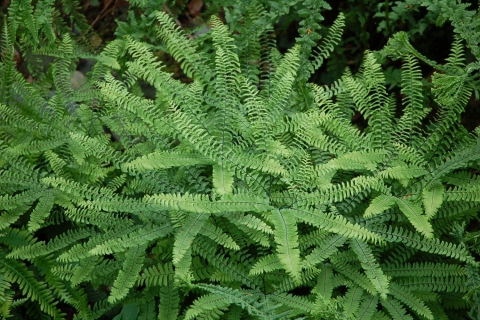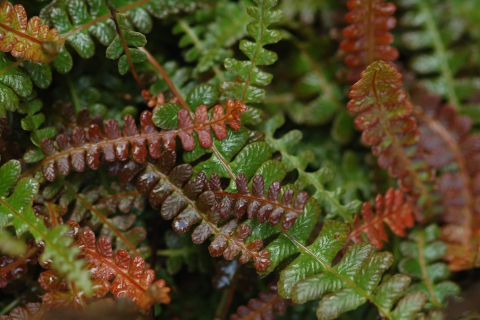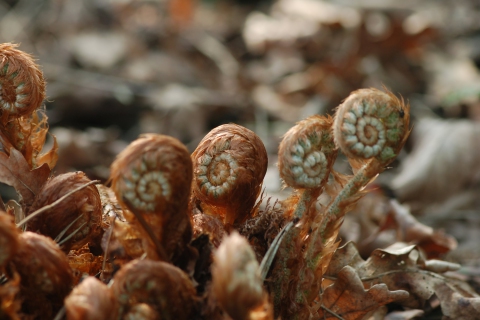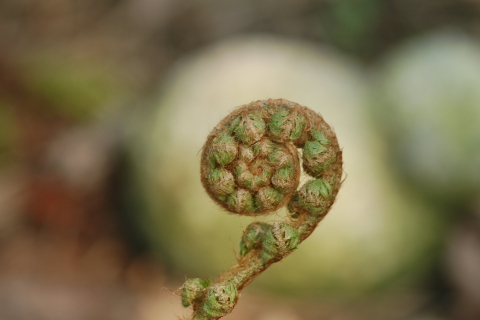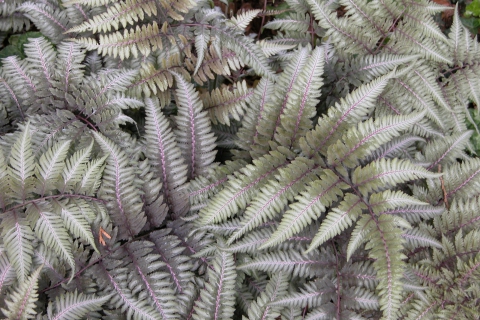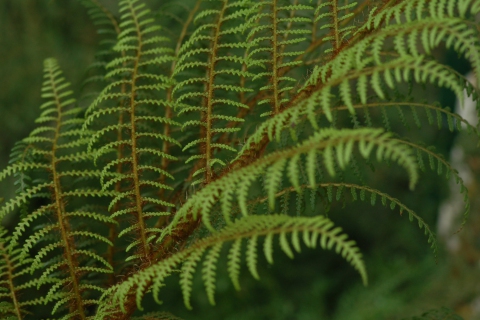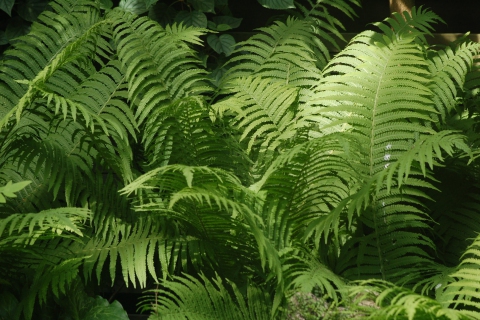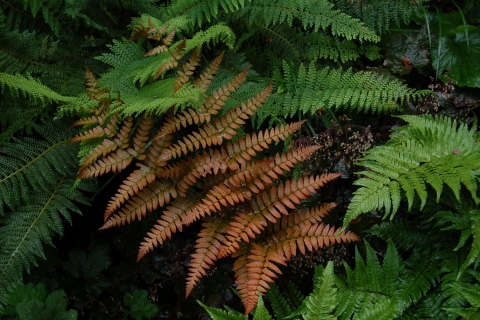Hidden sex life of ferns
In samenspraak met Phil Gates, een botanicus aan de Durham Universiteit - de derde universiteit van Engeland - mag de Nederlandse Varenvereniging een deel van z’n gevonden ’micro-varen-schatten’ op
haar website publiceren. Wij zijn hem daarvoor zeer erkentelijk.
The hidden sex lives of ferns, tekst en fotografie, Phil Gates [Botanist, Durham University, UK]
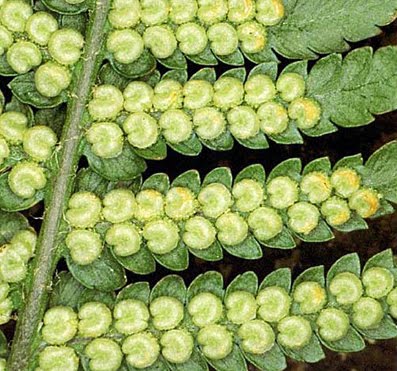 |
Fern spores are produced in vast numbers on the underside of fern fronds during the summer months. |
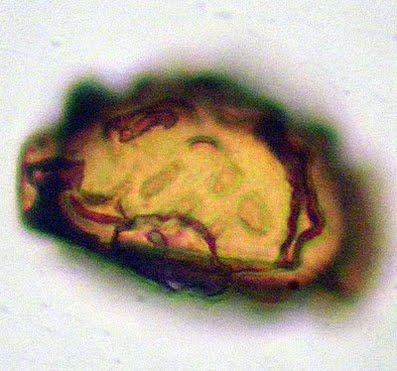 |
Each spore is less than a hundredth of a millimetre in diameter and can be carried vast distances on air currents. Ferns are often the first plants to colonise bare volcanic lava flows, carried there as spores on the wind. |
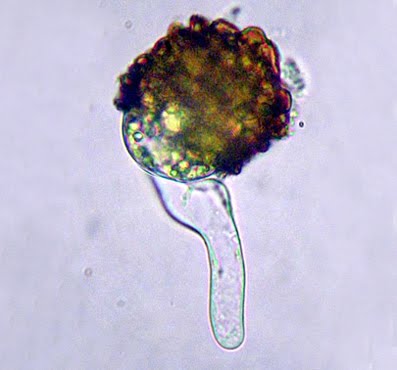 |
All they need for germination is water and mineral salts. They swell, the brown spore case splits open and a hair-like rhizoid emerges, that anchors the spore to its substrate. Then a green photosynthetic cell emerges from the spore. |
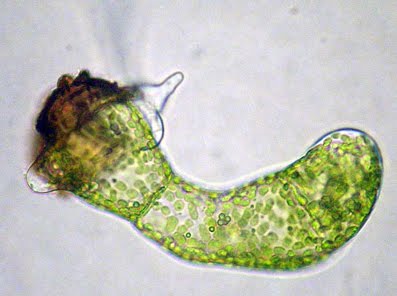 |
The photosynthetic cell divides longitudinally, forming the beginnings of a short chain of cells. The green blobs in the cells are chloroplasts. |
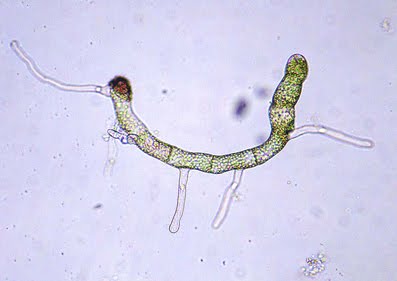 |
The chain of cells continues to elongate until it reaches 6 - 7 cells long, dividing longitudinally and producing more rhizoids to anchor itself more firmly. At this stage the remains of the brown spore coat is still visible. During this stage of development the plant must be constantly wet, even a short period of drought will be fatal. I sowed these spores in September, so they've taken about four months to reach this stage, where they appear to the naked eye as a green film covering wet soil. |
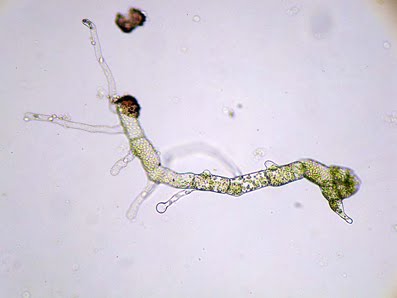 |
This is the next crucial stage in development and is about a millimetre long. The tip cell of the thread now begins to divide laterally and longitudinally, forming a flat plate of cells... |
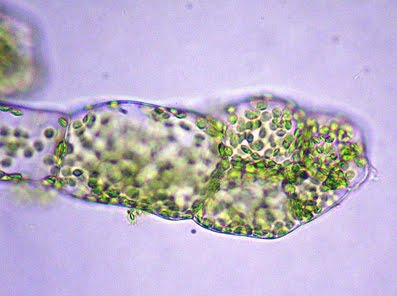 |
Here you can see this two-dimensional tip division at higher magnification. The flat plate of cells that develops from this is known as the prothallus, and this is where fern sexual reproduction takes place ...
|
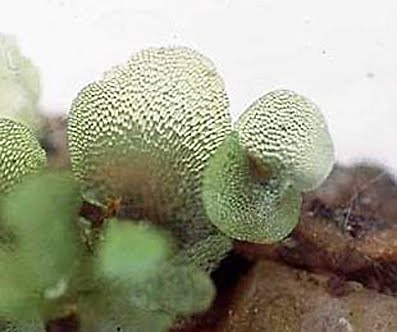 |
These are two fully developed prothalli, each about 5 mm. in diameter and only one cell thick. They are incredibly delicate and must remain permanently wet to survive. At this stage they are about six months old and male and female reproductive cells form on their surface.
|
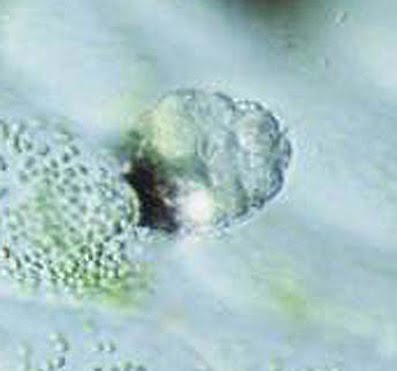 |
These are the male antherozoids, enclosed in a structure called the antheridium. When this bursts the antherozoids are released in swarms and swim, propelled by lashing flagellae, like tiny spinning tops in the surface film of water, in search of a female egg cell inside a long-necked structure called an archegonium, which you can see here.After a successful fertilisation an embryo develops which ultimately grows into a ...
|
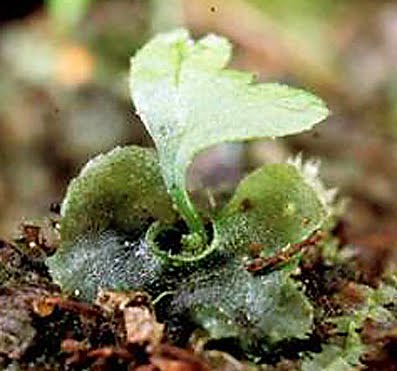 |
... New miniature fern plant. In the early stages, as seen here, it’s still attached to the prothallus formed by the germinated spore but that soon withers away and the new fern grows by producing a series of ever-larger fronds.
It usually takes about a year after sowing to reach this stage.
|
Provided you have the required patience, ferns are not difficult to grow from spores.
Met toestemming van Phil Gates overgenomen van zijn blog BEYOND THE HUMAN EYE Microfotografie van planten en insecten, o.a. Polypodyum, fern with golden sporangia
Hidden sex life of ferns
In samenspraak met Phil Gates, een botanicus aan de Durham Universiteit - de derde universiteit van Engeland - mag de Nederlandse Varenvereniging een deel van z’n gevonden ’micro-varen-schatten’ op haar website publiceren. Wij zijn hem daarvoor zeer erkentelijk. The hidden sex lives of ferns, tekst en fotografie, Phil Gates [Botanist, Durham University, UK] Fern spores are produced in vast numbers on the underside of fern fronds during the summer months. Each spore is less than a hundredth of a millimetre in diameter and can be carried vast distances on air currents. Ferns are often the first plants to colonise bare volcanic lava flows, carried there as spores on the wind. All they need for germination is water and mineral salts. They swell, the brown spore case splits open and a hair-like rhizoid emerges, that anchors the spore to its substrate. Then a green photosynthetic cell emerges from the spore. The photosynthetic cell divides longitudinally, forming the beginnings of a short chain of cells. The green blobs in the cells are chloroplasts. The chain of cells continues to elongate until it reaches 6 - 7 cells long, dividing longitudinally and producing more rhizoids to anchor itself more firmly. At this stage the remains of the brown spore coat is still visible. During this stage of development the plant must be constantly wet, even a short period of drought will be fatal. I sowed these spores in September, so they've taken about four months to reach this stage, where they appear to the naked eye as a green film covering wet soil. This is the next crucial stage in development and is about a millimetre long. The tip cell of the thread now begins to divide laterally and longitudinally, forming a flat plate of cells... Here you can see this two-dimensional tip division at higher magnification. The flat plate of cells that develops from this is known as the prothallus, and this is where fern sexual reproduction takes place ... These are two fully developed prothalli, each about 5 mm. in diameter and only one cell thick. They are incredibly delicate and must remain permanently wet to survive. At this stage they are about six months old and male and female reproductive cells form on their surface. These are the male antherozoids, enclosed in a structure called the antheridium. When this bursts the antherozoids are released in swarms and swim, propelled by lashing flagellae, like tiny spinning tops in the surface film of water, in search of a female egg cell inside a long-necked structure called an archegonium, which you can see here.After a successful fertilisation an embryo develops which ultimately grows into a ... ... New miniature fern plant. In the early stages, as seen here, it’s still attached to the prothallus formed by the germinated spore but that soon withers away and the new fern grows by producing a series of ever-larger fronds. It usually takes about a year after sowing to reach this stage. Provided you have the required patience, ferns are not difficult to grow from spores. Met toestemming van Phil Gates overgenomen van zijn blog BEYOND THE HUMAN EYE Microfotografie van planten en insecten, o.a. Polypodyum, fern with golden sporangia










